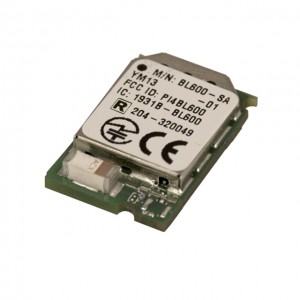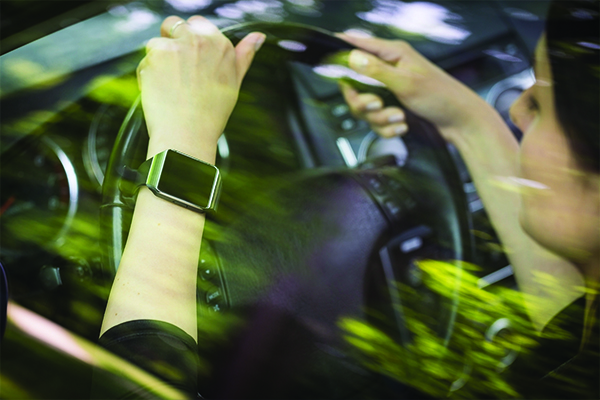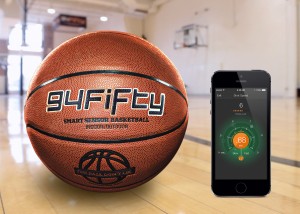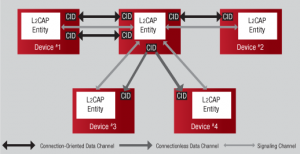The low energy protocols in the latest Bluetooth specification have taken the industry by storm. With the increasing focus on wearable computing, the low energy connectivity of Bluetooth LE is enabling a wide range of devices, from the Fitbit and Nike Fuelband fitness systems to Intel’s Edison PC on an SD card and even a smart basketball. The 94Fifty Smart Sensor Basketball from InfoMotion Sports Technologies measures and diagnoses both the frequency and quality of key skills critical to build confidence, versatility, and success on the basketball court using the new Bluetooth Low Energy specifications 4.0 and 4.1, which is now called Bluetooth Smart.
Everyday items such as watches, bracelets, gloves and even hats are being updated with Bluetooth wireless technology, allowing them to capture data and send it back to an application on a smartphone or tablet. Sports and fitness trackers made up 96 percent of wearable devices shipped in 2013 and ABI Research projects 32 million such devices with Bluetooth Smart will ship in 2014. This will further expand with smart watches, glasses and connected devices from baby onsies and bottle warmers to white goods around the home in the Internet of Things (IoT).
While powering a device from a small or rechargeable battery is key for the wearable market, the ability to run an embedded link for several years from one battery is driving the adoption of Bluetooth Smart for devices connecting to the Internet of Things.
The key to Bluetooth Smart is its ability to work with an application on the smartphone or tablet the consumer already owns. This makes it easy for developers and OEMs to create solutions that will work with the billions of Bluetooth enabled products already in the market today.
The cost, footprint and energy needs of Bluetooth Smart are miniscule and the technology can be added to practically anything, from watches to band-aids, with little or no changes to the look and feel of the original product.
Bluetooth LE uses the same 2.4GHz ISM band frequencies as the previous Classic Bluetooth but implements a simpler Gaussian frequency shift protocol to reduce the power consumption. It also uses smaller, 2MHz channels and direct-sequence spread spectrum (DSSS) modulation. This means that the LE and Classic specifications are not directly compatible, but the Bluetooth certified chips and modules operate in a dual mode that supports both.
The Bluetooth Smart technology uses 40 of the 2MHz channels, giving a link bit rate of 1Mbit/s and an application throughput of 270kbit/s. However, this lower bit rate for applications is offset by reducing the latency to 6ms from the 100ms of the classic Bluetooth to enable more monitoring applications. The maximum transmit power is also reduced to 10mW, reducing the range to under 50m, which is more than sufficient for the short range wearable and home applications.
Initially, the Bluetooth Smart Ready indicated a dual-mode device, typically a laptop or smartphone, whose hardware is compatible with both Classic and LE Bluetooth peripherals, while the Bluetooth Smart label indicates an LE-only device.
Now, the latest version, Bluetooth 4.1, allows devices to support multiple roles simultaneously so that a Bluetooth Smart Ready product can act as a hub and a peripheral at the same time. The coexistence with other wireless technologies, notably WiFi on the same 2.4GHz band, has been improved, and dedicated channels have been added for IoT applications.
This Logical Link Control and Adaptation Architecture (L2CAP) supports higher-level protocol multiplexing, packet segmentation and reassembly and quality of service information with 64Kbyte packets. The architecture is based around channels where each endpoint has a channel identifier (CID). The CID assignment is relative to a particular device and a device can assign CIDs independently from other devices, making it easy to add devices to a network.
Module makers such as Laird Wireless combine the Bluetooth Smart chips such as the Nordic Semiconductor nRF51822 with an antenna and interfaces, all in a compact footprint of 19 mm x 12.5 mm. The modules incorporate all the hardware and firmware required to support development of BLE applications, including UART, SPI, I2C, ADC, and GPIO interfaces for connecting peripherals and sensors for the BLE profiles that include Blood Pressure, Heart Rate, Health Thermometer, Proximity and Find Me.


Figure 3: The Bluetooth Low Energy module from Laird Wireless is pre-qualified for adding to existing designs
Module makers also add their own capabilities such as smartBASIC. This is an event-driven programming language that enables standalone operation of the module whereby sensors can be attached via any of the interfaces without the need for an external processor. A simple smartBASIC application encapsulates the complete end-to-end process of reading, writing, and processing of sensor data and then using BLE to transfer it to any Bluetooth v4.0 device – smartphone, tablet, gateway, or computer. Ultimately smartBASIC accelerates initial development, creation of prototypes, and mass production.
In addition to carrying FCC modular, IC, CE and MIC approvals, the modules can be fully qualified as a Bluetooth End Products. This enables designers to integrate the modules in their existing devices without the need for further Bluetooth Qualification, dramatically speeding up developments.
Other module makers such as BlueGiga and connectBlue are using BLE silicon from Texas Instruments for modules that support v4.0. The BluGiga BLE113 module can be powered directly from a standard 3V coin cell battery or two AAA batteries to fit into the smallest designs from key fobs to iPhone accessories. In the lowest power sleep mode it consumes only 500nA and will wake up in few hundred microseconds to extend the battery life. The connectBlue (CB-OLS425I-04-0) module integrates a temperature sensor and accelerometer and can run for up to 10 years from a coin cell battery.
Chip maker CSR also provides a complete set of tools for software development, board design and production test around its uEnergy chip. This chip sits on a reference module with a USB programming interface and interfaces for breaking out I/O to application-specific sensors and actuators. The fully licensed CSR xIDE software development environment includes example applications for popular Bluetooth Smart profiles and host applications for both iOS and Android smartphones to simplify the project. The Target board is normally powered from the host USB connection but can also be run standalone from an on-board coin cell to allow power measurements to be made.
A whole new generation of portable, wearable and connected home equipment is set to take advantage of Bluetooth Smart technology. With the 4.0 and 4.1 versions of Bluetooth Low energy, equipment can be easily connected up to smartphones and tablets for a wide range of new applications. Pre-qualified modules and development kits to support highly integrated silicon devices help developers add this capability quickly and easily to existing and new designs.










